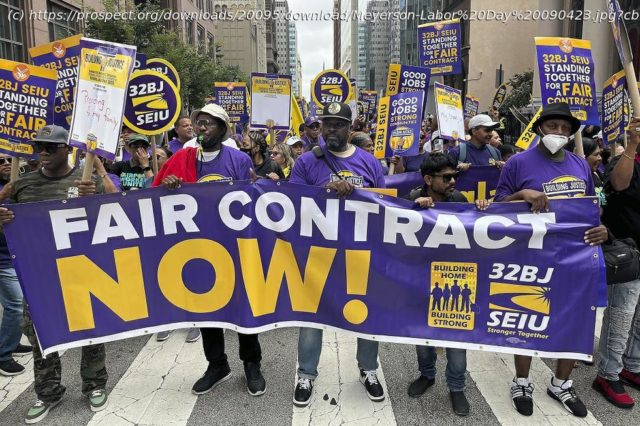With public support for unions at near-record highs and new federal rules that actually enable organizing, unions need to mount massive campaigns.
Members of Service Employees International Union Local 32BJ march through Center City on August 29, 2023, in Philadelphia. As building owners try to cut back hours for cleaners and janitors, the union rallies for a fair contract.
Labor Day 2023 isn’t like Labor Day 2022. It isn’t like any Labor Day of the past half-century.
The reason is simple: Labor law has changed.
Two Fridays ago, the National Labor Relations Board restored a good deal of labor law to its original purpose of enabling workers to bargain collectively for better pay and working conditions.
In its decision in the Cemex case, the Board ruled that when a majority of workers at a company or worksite affiliate with a union (something they could do by signing affiliation cards), the employer could either recognize that union voluntarily or request that the Board hold an election. If, during the run-up to the election or the election itself, the employer committed an unfair labor practice (ULP), the Board would immediately declare the union recognized and order the employer to begin bargaining with it.
That, to put it mildly, was a fundamental change to the law of the past 50 years, which court decisions and Republican-dominated NLRB rulings had tilted heavily to employers’ interests. During that time, there was no effective punishment when employers committed virtually any unfair labor practice under the sun in their invariably successful efforts to squelch their workers’ campaigns to unionize. Their most effective ULP was firing or threatening to fire pro-union employees, for which the “penalty” was to be ordered, after a process that could take several years, to rehire those employees and give them back pay, minus anything those workers had earned at other jobs since being fired.
There are a host of reasons why the share of private-sector workers who belong to unions has declined from roughly 35 percent 70 years ago to a bare 6 percent today (offshoring, state “right to work” laws, and so on), but the firing of workers who’d otherwise vote to go union was the most effective.
The centrality of firing to union deterrence has been made clear in recent years by the successful unionization efforts of workers who can’t be fired because they can’t really be replaced: professionals like university teaching and research assistants, medical interns and residents, museum staffers, think-tank policy experts, journalists at the handful of still-solvent news outlets, or foundation grant-makers. Their unionizations have been sweeping the country in the past two years, while the share of unionized sales clerks, mechanics, waitstaff, kitchen, warehouse, and assembly-line workers, all of whom can be replaced, has continued to decline.
In the (I shudder to think) six decades that I’ve been writing about unions, I’ve probably read at least three dozen books and I don’t know how many papers on strategies that could enable unions to grow again. I’ve seen anciens régimes ousted by insurgents who pledged they could revive their unions again. Yet every year, the share of unionized private-sector workers has continued to drop.
Strategies mattered, of course, but none of them could overcome the hard realities of the law: Once employers started coercing their workers, subjecting them to anti-union propaganda meetings, and firing the workers’ leaders, strategy was as naught.
With the NLRB’s ruling in Cemex, that has ceased to be the case. And it’s already having an impact. Workers at a Trader Joe’s in Manhattan whose union election ended in a 76-76 tie (therefore lacking a majority) filed with the Board last week that ULPs by the company during that election should, under the Cemex decision, nullify the election and allow their union to be immediately recognized.
With that, the post-Cemex era has begun.
THE CEMEX DECISION WASN’T THE ONLY decision the Board has announced in the past ten days. It also has issued rulings to speed up the timing of elections and to protect individual workers who, by their lonesome, begin agitating for a union.
Cemex, however, doesn’t cover all the ways that management can avoid unionization even when a clear majority of its workers have affirmed that they want a collectively bargained contract. Cemex can compel a union-busting employer to start bargaining, but it can’t compel that employer to actually reach agreement with workers and sign a contract. Unfortunately, that too is a tactic that employers routinely use to maintain control of their workers. Starbucks has refused to seriously bargain with workers at the more than 300 outlets where workers have voted to unionize, just as Amazon has refused the same with the unionized workers at its Staten Island warehouse.
The reason the Board didn’t address that issue in Cemex is that the National Labor Relations Act expressly prohibits the Board from imposing a contract if the parties fail to come to terms, or to appoint an arbitrator who could do that. In congressional Democrats’ more recent attempts to amend the NLRA so that it is no longer a tool for union-averse employers, they’ve included language that would permit the Board or its arbitrators to impose a first contract after a certain amount of time (could be 90 days, could be 180) has elapsed with no resolution in sight. But none of the Democrats’ bills to strengthen labor law, which date back to Lyndon Johnson’s presidency, have been able to surmount the 60-vote cloture hurdle in the Senate.
The NLRB may now have the votes in the Senate to continue its recent string of pro-worker rulings.
The NLRB may now have the votes in the Senate to continue its recent string of pro-worker rulings.
That apparently hasn’t daunted the moving spirit behind Cemex, NLRB General Counsel Jennifer Abruzzo, the Biden appointee who has become the most effective public official to champion the cause of American workers since New York Sen.






